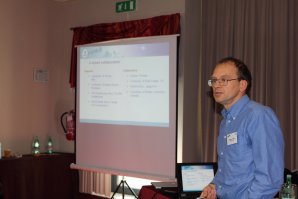Tasks and Partners
The Muons JRA

Stephen Cottrell, the JRA coordinator.
Task 1: JRA management activities
STFC, as co-ordinator, seeks to undertake management and co-ordination activities. This will include stimulation of twelve monthly JRA partner meetings, preparation of all required reports, maintenance of a Muon JRA website including reports, meeting notes, technical documents, etc, publicising the muon JRA within the wider NMI3 consortium, and budget management. In addition to the formal JRA meetings, there will be regular informal contact between partners to discuss JRA work.
Task 2: Software Development for Muon Data Analysis
Co-ordinator: STFC
Partner: PSI
Summary: This task area aims to develop state of the art data reduction methods applicable to new applications of the muon technique in subject areas such as soft matter, semiconducting materials and radical chemistry. The recent development of complex experimental methods (such as high field, laser, RF and gas phase studies) has highlighted the important role that simulation now plays in data analysis, and tools to combine instrument simulation (developed during previous JRAs) with analysis will be developed. Improved data formats, particularly including advanced metadata, will be devised to underpin the new analysis techniques.
Specific Aims:
- Development of routines for efficient analysis of high field experiments. This is likely to include code to improve the analysis of time domain Avoided Level Crossing measurements – the aim will be to incorporate routines within a supported analysis framework.
- Developing routines to link simulation code developed as part of the muon JRA activities during FP6 and FP7 with existing analysis programs. This is likely to include code to simulate the muon stopping profile in gas and pressure cells and evaluate coincidence with applied stimuli.
- A document considering how the existing NeXus Instrument Definition File may be augmented to better support novel analysis techniques through the introduction of additional metadata. Specific examples may be implemented during the JRA.
Task 3: Concept Studies for Future Muon Sources
Co-ordinator: PSI
Partner: STFC
Observers: Parma, Huddersfield, ESS, RIKEN-RAL
Summary: This task area will take a forward look at the next generation muon sources, instrumentation and user requirements (such as specialised sample environment), using simulation to develop preliminary design studies as to how these might be realised. Work is likely to be focussed in two areas: firstly, to evaluate how novel muon-beam facilities might be realised and their impact on the scientific community, and secondly, to consider how high intensity muon sources might be implemented and consider the associated scientific benefits.
Specific Aims:
- Concept study for advanced muon beams (e.g. micro-beam). The application and impact of such beams will be assessed, and the need for specialised sample environment equipment (as using anvil cells for very high pressures on micro-beams) considered.
- Concept study for future high intensity muon sources; examining how, for instance, improved production target technologies, beam optics and future facilities, such as the ESS, might be used to provide new high intensity muon channels. The potential applications of high intensity muon beams will be assessed.
Task 4: Detector Technologies for Pulsed Muon Sources
Co-ordinator: STFC
Partner: PSI
Summary: This task area will involve collaborative work to characterise a prototype detector bank based on Geiger-mode Avalanche Photo Diodes (APD) for the ISIS High Field Instrument. APD technology was developed by PSI during previous JRAs for continuous muon beams, and the aim of this task is both technology transfer and innovation to enable its application to the pulsed beams at ISIS. The prototype bank will be designed to function as both a longitudinal and transverse array, and in the latter configuration RF experiments will be performed to evaluate its timing resolution.
Specific Aims:
- Design document for a prototype APD detector for the ISIS High Field Instrument (HiFi). In particular, this will involve an extended visit by ISIS staff to PSI to identify key technical challenges and specify appropriate components.
- Prototype APD detector for the HiFi instrument, designed to operate both as an additional transverse bank (specifically for pulsed RF experiments and requiring good timing resolution) and a longitudinal array.
- Document discussing the performance of the APD detector array, and considering whether APD technology is currently viable for replacing traditional Photomultiplier tube technology at pulsed muon sources.